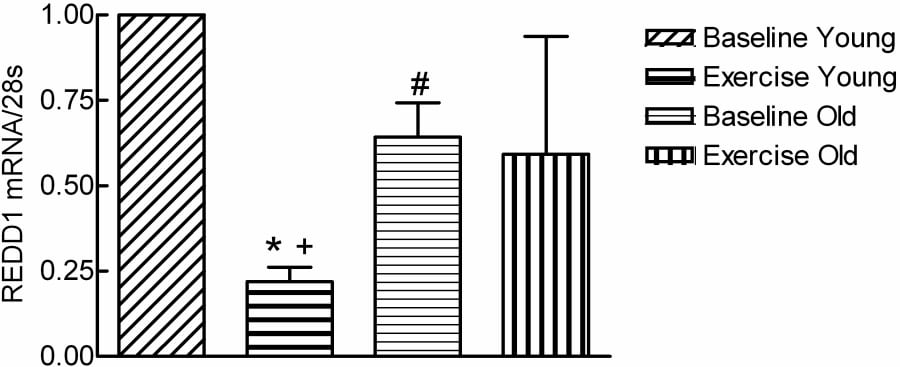After a latent period ~1 h post resistance exercise (RE), muscle protein synthesis (MPS) is increased markedly. Previous studies have shown that upregulation of mammalian target of rapamycin complex 1 (mTORC1) signalling is associated with RE-induced MPS through activation of upstream kinases and protein complexes such as Akt, p70S6K1 and TSC1/2, probably through growth factor/mechanosensitive-dependent mechanisms. REgulated in Development and DNA damage responses (REDD1) is a recently identified novel mTORC1 repressor whose transcription is rapidly modulated, and is inversely proportional to mTOR signalling activity (Kimball et al 2008). Thus we hypothesized that REDD1 mRNA expression would be downregulated by exercise as part of the facilitation of mTOR-mediated increases in MPS. We further hypothesized that the downregulation of REDD1 mRNA expression would be greater in young than old women thereby possibly providing a more potent anabolic stimulus in young women. Twenty two healthy women (old n=9 median age 80 y, range 76-82 y; young n=13, median age 26y, range 19-30 y) undertook a single bout of RE (120 maximal voluntary isometric contractions of the knee extensors of one leg as 20 sets of 6 contractions over 90 minutes). Muscle samples were obtained from the lateral mass of the quadriceps under local anaesthesia (1% lignocaine sc) at baseline and at 2.5 h post-exercise using the Bergstrom needle technique. Changes in muscle mRNA concentration for REDD1 were determined by real-time RT-PCR using pre-validated 28s rRNA to correct for variations in preparation. Statistical analysis was by repeated measures (RM) ANOVA. In old women at rest muscle REDD1 mRNA was ~30 ± 10 % lower than in muscle of young women (P<0.05) and was unchanged by exercise (Figure 1). In young women, exercise led to an ~80 ± 4 % reduction (P<0.01) in muscle REDD1 mRNA, an expression level that was also significantly lower than that in muscle of old women at rest (P<0.05). We speculate that the potent downregulation of REDD1 mRNA in young women may be paralleled by a similar decrease in REDD1 protein expression which possibly contributes to increased mTOR signalling and greater initiation of MPS after RE. However, the inability to further respond to RE with downregulation of REDD1 mRNA may limit anabolic responses to RE in old women. Our novel results are consistent with the accumulating evidence for dysregulation of MPS in response to anabolic stimuli in old age.
University of Cambridge (2008) Proc Physiol Soc 11, PC27
Poster Communications: Transcription of the mTOR repressor REDD1 is lower in old women at rest and is downregulated after resistance exercise in young but not old women
C. A. Greig1, D. Rankin2, A. Young1, V. Mann1, B. Noble1, P. J. Atherton2
1. School of Clinical Sciences and Community Health, University of Edinburgh, Edinburgh, United Kingdom. 2. School of Graduate Entry Medicine and Health, University of Nottingham, Derby, United Kingdom.
View other abstracts by:
Figure 1: Effect of resistance exercise on mean (SEM) REDD1 mRNA (relative units normalised to baseline for young) for n=9 old and n=10 young women. *+# = P<0.05 (RM ANOVA). * Significantly less than at rest; + significantly less than old women at rest; # significantly less than young women at rest.
Where applicable, experiments conform with Society ethical requirements.

